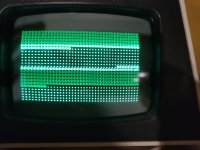Desperado: You did have the option to build the adapter board I suggested to examine your memory. Also, using it, if your computer booted normally with it and ran BASIC in 2k mode and ran small programs, you could have been confident that there wasn't another problem hiding on the board, other than DRAM memory & its support circuitry that you needed to look for first.
Then you could have examined the DRAM memory bytes and easily worked out which of your DRAM IC's were faulty according to the methods in the detailed article and the diagram there. But you chose not to go down that road.
However, as Daver2 says, your skills do need improving, the adapter would actually be a good small construction project for you, to make it, to also improve those skills. Many people develop their electronics skills with various construction projects. It especially helps with soldering skills. You are not completely without skills though, so you can be congratulated, especially for your effort, but overall the skills are not yet at a level for generally successful vintage computer repairs and it requires too much hand holding by Daver2, who, as the old saying goes, has the patience of Job.
I also pointed out that if you made the adapter, you could use it on future PET repairs and keep in your tool kit. But you said this PET was a special case. But it isn't really. Many PET's with soldered in DRAM's have the issue of trying to figure out if 1) it is a DRAM issue or something else related to their operation and 2) which of the specific DRAMs IC's are defective. Your board is far from a special case in this respect, though as Daver2 pointed out, he has not seen this particular fault before and we all want to find out what fault/s are causing it.
You also fell for the trap of replacing IC's on hunches. This is a poor proposition, because there is a risk of introducing new faults such as pcb damage and shorts. The IC's you fit might be faulty and/or not ideal. (For example you said you fitted LS153, but the originals are 74153, probably ok but not 100% certain in every case). Now you have seen that things have "changed" which could mean another fault is added and it likely means the original 74153's were ok. This is how many people get themselves into a real pickle with repairs. An IC should only be removed where there is good evidence, based on measurements, to indicate it is actually defective.
I once repaired a pcb for a person who had a go at it. The board contained about 65 TTL IC's, they replaced about 35 IC's and got nowhere on hunches. By the time I fixed it, the original defective IC was not one they replaced. They introduced pcb damage and a "new" IC they had installed was also defective. The board of course, in the end, though I got it functionally working, was ruined and it also had no historical value either because of all the pcb patches and non original IC's.

